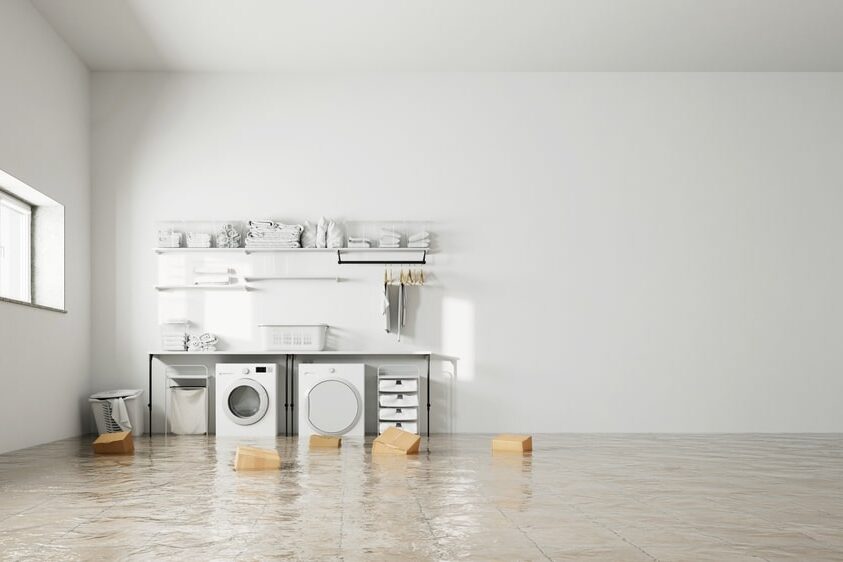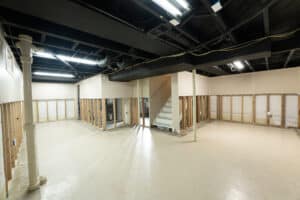At Cleanup & Total Restoration, we know how overwhelming a flooded basement can be. In just minutes, water can seriously damage flooring, walls, and furniture. And within 48 hours, mold growth becomes a major concern.
We’ve put together these essential tips to help you recognize common causes, identify early warning signs, and take immediate action when basement flooding strikes. With the right steps, you can regain control and start restoring your home quickly and safely.
Table of Contents
Common Causes for Basement Flooding
Basement flooding can happen for a number of reasons, and it often starts without warning. Whether it’s heavy rain, a broken pipe, or a failed sump pump, water can quickly find its way into your basement and cause serious damage.
Understanding why basements flood is the first step toward protecting your home. Some causes are easy to spot, while others may stay hidden until it’s too late.
Here are some of the most common reasons for basement flooding:
- Heavy Rainfall & Poor Drainage: Idaho’s clay-rich soil doesn’t drain well. During storms, water tends to collect around the foundation instead of flowing away from the home.
- Sump Pump Failures: If your sump pump gets clogged, water can build up fast and flood your basement.
- Burst or Leaking Pipes: Cold weather, old plumbing, or high pressure can cause pipes to crack or burst. This is especially common in unfinished or poorly heated basements.
- Sewer Backups: Wastewater can back up into your home when your property experiences a sewer backup. This causes a dangerous and unsanitary mess.
- Foundation Cracks & Poor Waterproofing: Even small cracks in your basement walls or floors can allow groundwater to seep in, especially during snowmelt or heavy rain.
- Appliance Failures: Water heaters, washers, and other appliances in the basement can release gallons of water if they leak or break down unexpectedly.
Sometimes the warning signs are subtle—a musty smell, damp spots, or a slow trickle of water. Other times, it’s sudden and overwhelming. Either way, knowing the cause behind basement flood damage can help you respond quickly and prevent future flooding.
What To Do When You Have a Flooded Basement
A flooded basement can become overwhelming, fast. The sooner you begin cleanup, the easier it is to prevent long-term structural damage, stop mold growth, and protect your belongings.
Here’s what you need to do—step by step—to stay safe and minimize basement flood damage:
Step 1: Ensure Safety First
Before doing anything else, make sure you’re safe. Floodwater and electricity are a dangerous mix, and contaminated water can pose health risks.
- Do not enter standing water if there are electrical outlets, cords, or appliances submerged.
- If it’s safe to do so, shut off power to the basement from a dry location. Never touch a wet electrical panel.
- Wear protective gear if you suspect the water contains sewage or chemicals.
Step 2: Identify & Stop the Source of Water
Once you’re safe, the next priority is identifying the source of the water. Stopping the flow can prevent further damage.
- Look for common causes: burst pipes, overflowing sump pumps, foundation leaks, or water seeping in from heavy rain.
- In the Boise area, clay-heavy soil makes drainage difficult. During storms, water often pools around foundations and enters through cracks or window wells.
- If you can’t locate or stop the source, call a professional water damage restoration team immediately.
Step 3: Pump Standing Water Out of the Basement
Once the source is under control, it’s time to remove the water.
- For small amounts, a wet-dry vacuum can be helpful. For any standing water more than an inch or two, professional water extraction equipment is safer and more effective.
- Remove water as quickly as possible. The longer water sits, the more it seeps into flooring, drywall, and insulation.
Step 4: Salvage Valuables & Remove Damaged Items
Once the water is removed, begin clearing out your space to protect your belongings. You’ll want to protect valuable items such as photos, documents, electronics, and sentimental items.
- Move undamaged valuables to a dry area right away.
- Dispose of water-damaged items that can’t be cleaned or dried, especially porous materials like carpet, upholstered furniture, and insulation.
- Take photos for insurance claims before discarding anything.
Step 5: Clean & Inspect for Mold or Mildew
Even after water is removed, hidden moisture can linger. Any remaining moisture will trigger mold growth within 24–48 hours. To avoid this:
- Use fans, dehumidifiers, and ventilation to dry the space as much as possible.
- Disinfect surfaces that came in contact with floodwater.
- Watch for signs of mold: musty odors, discoloration, or fuzzy growth on walls and floors.
- Reach out for professional mold removal and remediation.
Who To Call When Your Basement Floods
When you have a flooded basement, knowing who to call can make all the difference in how quickly and safely your home is restored.
Depending on the severity, you may need to reach out to your home insurance provider, a licensed plumber, an electrician, and a professional restoration company.
At Cleanup & Total Restoration, our certified team is available 24/7 for expert water extraction, drying, and dehumidification. We respond fast and work directly with your insurance to make the process easier.
Preventive Measures for Basement Flooding
While not every emergency is preventable, there are practical basement flooding solutions you can take to minimize the risk.
Improve Drainage and Exterior Defenses
Clogged or dirty gutters can’t effectively direct water away from your home. This increases the risk of basement flooding.
Regularly cleaning gutters and extending downspouts at least six feet away from your foundation helps keep water flowing away from vulnerable areas. Additionally, installing French drains or other water diversion systems can provide extra protection.
Seal & Waterproof the Foundation
Over time, your foundation, walls, and floors might develop cracks from water intrusion. This is dangerous for structural damage, but also increases the risk of a flooded basement.
The best way to prevent basement water leaks is by quickly repairing cracks, applying waterproof sealants, and installing backwater valves.
Install & Maintain Sump Pump Systems
Your sump pump is your basement’s first line of defense against flooding. But, like any system, it can fail due to power outages, mechanical issues, or clogs.
To keep it running when you need it most, test your sump pump regularly, clear the pit of debris, and install a battery backup in case of power loss. For added protection in high-risk areas, consider installing a secondary pump.
Get Regular Inspections
Preventive maintenance is one of the most effective basement flooding solutions. Annual inspections of your plumbing, drainage, and waterproofing systems can catch small issues before they lead to major water damage.
How Cleanup & Total Restoration Can Restore Your Flooded Basement
If you’re dealing with a flooded basement or have noticed any of the warning signs, it’s never too early to take preventive action.
Cleanup & Total Restoration (CTR) is your trusted partner for fast, professional help. With over 25 years of experience restoring homes in the Boise area, our IICRC-certified technicians approach every job with skill, urgency, and care.
We’ll start with a thorough inspection, identify the source of moisture, and develop a customized restoration plan to get your home back to normal. When you call, our team arrives on-site in 60 minutes or less, ready to work.
We coordinate directly with your insurance provider and never charge hidden fees. Let our team help protect your home, your family, and your peace of mind.









